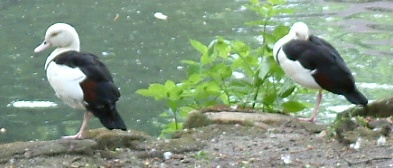Radjah Shelduck
From Wikipedia, the free encyclopedia
[Photo] Tadorna rajah. Date: 18 June 2005. Photo by http://commons.wikimedia.org/wiki/User:Radomil
The Radjah Shelduck (Tadorna radjah), in Australia also known as Burdekin Duck, is a species of shelduck. Currently placed in the genus Tadorna, it differs markedly in external morphology, and mtDNA cytochrome b sequence data (Sraml et al. 1996) suggests its status should be reinvestigated.
Both the male and female of the species are mostly white, with dark wingtips and a distinctive "collar" of dark feathers. Seen from above in flight, the birds have green bands on the tops of their wings. The female has a harsh rattle and the male has a breathy, sore-throat whistle.
The Radjah Shelduck's inhabits to mangrove forests and coastline of New Guinea and Australia. In Australia, its primary range takes in much of coastal tropical northern Australia, from central Queensland through northern Northern Territory (including Kakadu National Park) to the Kimberley in Western Australia.
The species prefers the brackish waters of mangrove flats and paperbark tree swamps, but will visit freshwater swamps, lagoons, and billabongs further inland during the wet season.
The Radjah Shelduck forms long-term pair-bonds, and is usually encountered in lone pairs or small flocks. During the wet season the males commonly become very irritable, and have been observed attacking their mates.
The diet consists mainly of mollusks, insects, sedge materials and algae. Pairs start searching for nesting sites during the months of January and February. They nest close to their primary food source, often in the hollow limbs of trees, which makes habitat destruction a particular issue.
Radjah Shelduck doesn't use nesting materials except for some self-supplied down feathers. Egg-laying is usually done by May or June, but depends on the extent of the wet season. The clutches range from 6 to 12 eggs. Incubation time is about 30 days.
The Radjah Shelduck is listed as a protected bird in all states of Australia and extremely harsh penalties exist for harming or disturbing them.
http://en.wikipedia.org/wiki/Radjah_Shelduck
| The text in this page is based on the copyrighted Wikipedia article shown in above URL. It is used under the GNU Free Documentation License. You may redistribute it, verbatim or modified, providing that you comply with the terms of the GFDL. |
|

